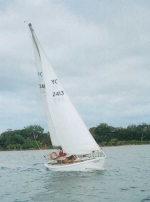
An 8.3?

Still not sure?
Columbia made its way in the boat building world by creating a fiberglass version of the Islander 24, a wooden boat. Ironically, one of the last Columbia designs was first built in wood and then turned into a fiberglass boat.
I received an email from Tony Legg of Australia. He wrote:
"Hi Im just checking to see if this address is current
Please reply if so
Regards
Owner Alan Payne Prototype for Columbia 8.3"
That got my attention. I assured him that the address was still good and I asked for more information. He responded with a file talking about the boat and quoting Alan Payne, and he included four pictures. (click on the pictures for larger versions)
 An 8.3? |
 Still not sure? |
 Look close and see the wine glass transom. Apparently the made both sides match after the tests. |
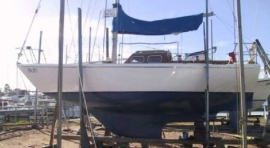 Check the keel!. | 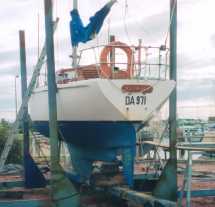 Here's another angle. |
The keel does look a lot like an 8.3, but clearly the house has no resemblence to an 8.3
Farrago was a prototype for a hull designed by Alan Payne (iconic Australia navalarchitect and designer of the famous America’s Cup Challengers Gretel 1 and Gretel 2) forThe Columbia Yacht Company in Virginia, USA.
Farrago's hull design reflects an attempt to combine maximum livable space below (via a broad beam and relatively flat bilge) with optimum sailing characteristics. This wasachieved by designing a hull shape which maintains excellent fluid dynamic qualitiesthroughout the normal range of heeling angles.
Farrago is built in the traditional carvel planked method, in which planks are laid over regularly spaced, laminated ribs and made watertight by means of a thin strip of woodglued into a trough routed along the join between the planks.Farrago differs from older yachts built in this traditional way because vapor- resistant epoxy resin (West System) was used throughout as the adhesive for laminating andjoinery and as the "primer" (both inside and out) over the raw wood. This method ensuresthat her wood remains "dry" (i.e. its moisture content does not vary significantly), whichin turn means that the useful life of her hull is several times that of traditionally built"wet" hulls.
Farrago was built with great care and attention to detail by a fully qualified andexperienced shipwright (Allan Smith) at the Shrike Boat Company in South Australia.Her fittings are of premium quality (e.g. brass and stainless steel fittings are used throughout) and, as with her rigging, are invariably much stronger than those which would normally be found on a mass-produced yacht of her size.The method and quality of Farrago's construction and the sturdiness of her fittings mean that her structural strength is probably equal to any yacht of her size in Australia today. Combined with her heavy rigging, this sturdiness means that Farrago is truly a sea-going yacht, capable of withstanding the most severe conditions that might be experienced on an ocean voyage.
"There has always been the thing that cruising yachts were a kind of watered-down version of current racing yachts. The amount of design thought that has gone into cruising yachts was nowhere near what it should have been. The Super-Cruiser design is intended to be a balance of good handling qualities, safety and ability in rough weather and speed. The interesting and special thing about this design is the very good performance which has been achieved over the whole range of cruising requirements."
"The final satisfactory result was achieved by combining a wide beam, a flat-bottomed shape amidships with firm bilges, and bow and stern shapes which are different to the shapes adopted nowadays in rather thoughtless imitation of shapes which have been developed to fit the geometry of racing rule."
"The bow shape has been chosen principally for its effect on steering. The U-shape reduces weather helm when the Yacht is heeled and makes the boat much easier to steer in a following sea. On top of the veed stern there is a fairly wide spreading out transom in the style of the early American yachts like the schooner 'America'. This stern confers useable deck space and acts as a very good pitch dampening device when the yacht is heeled over."
"The net result of the bow, amidships, and a stern shape is a boat which imparts tremendous confidence in rough weather. It keeps going fast, it has an easy motion, it is dry, and it is easy to steer. It is also stiff and stable and carries its sail well. It's a boat with which the owner can go on board and find that she is particularly easy to manage in all sailing conditions."
-Alan Payne
I dug into my archives and found my reprint of an article by Danny T. Greene that was published in March 1976 issue of Cruising World. I was a little disappointed that it was about the 8.7, not the 8.3, but I checked it out anyway. Here is the article:
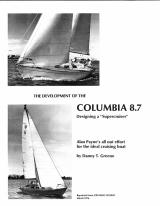 | 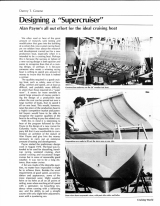 |  | 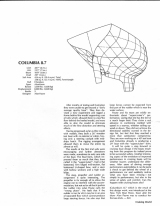 |
| Front | page 2 | page 3 | Back |
The interesting thing about this article is that although it is about the 8.7, the wooden test boat is a 26 footer - a shade shorter than 8.3 meters - not an 8.7. The other interesting thing is that the prototype had no cabin, which would explain why the house on the prototype doesn't look like an 8.3. It was added later.